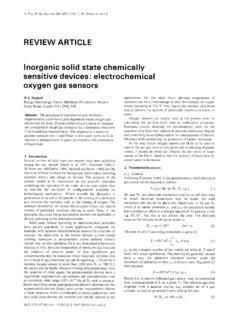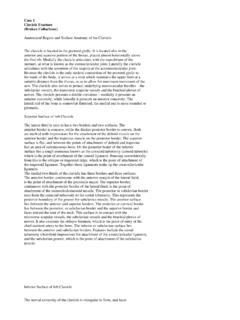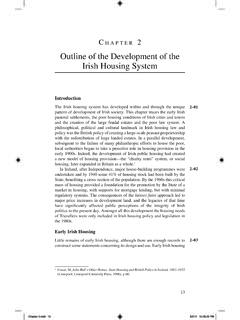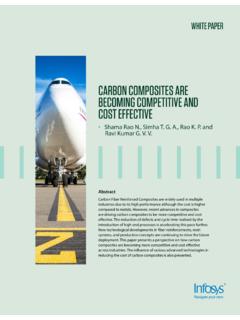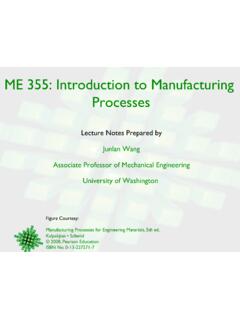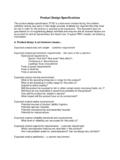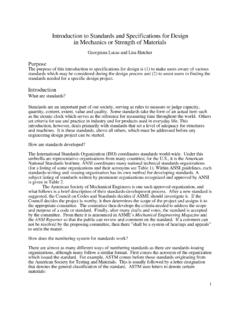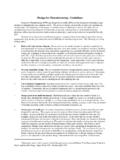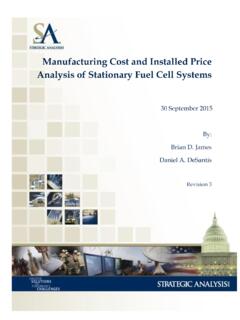Transcription of 15. Flexible Manufacturing Systems - NUI Galway
1 15. Flexible Manufacturing Systems Unit Introduction Unit Objectives Flexible Manufacturing Systems FMS Components FMS Applications and Benefits FMS Planning and Implementation Issues Quantitative Analysis of FMS Unit Review Self Assessment Questions Self Assessment Answers Introduction Flexible Manufacturing Systems (FMSs) are the most automated and technologically sophisticated of the machine cell types used to implement cellular Manufacturing . An FMS usually has multiple automated stations and is capable of variable routings among stations, while its flexibility allows it to operate as a mixed model system. The FMS concept integrates many of the advanced technologies that we met in previous units, including Flexible automation, CNC machines, distributed computer control, and automated material handling and storage. KEYPOINT A Flexible Manufacturing system (FMS) is a highly automated group technology machine cell, consisting of a group of processing workstations that are interconnected by an automated material handling and storage system, and controlled by a distributed computer system.
2 END KEYPOINT In this unit we examine the question what is a FMS? , which requires an analysis of the meaning of the term flexibility, and the types of FMS that can be met. An investigation of FMS components workstations, material handling and storage, computer control, and human resources succeeds this and we examine FMS applications and benefits. FMS planning and implementation issues looks at FMS design recommendations, and operational issues that can occur with the FMS. Some quantitative analysis of the FMS concept in terms of its operating parameters for the bottleneck model, and trying to determine the appropriate size of an FMS. Learning Objectives After completing this unit you will be able to: BULLET LIST Specify what is meant by a Flexible Manufacturing system. Explain the concept of group technology, and how it relates to cellular Manufacturing . Specify the three primary capabilities of flexibility in the FMS. List the four tests for flexibility in FMS research.
3 Explain how different types of FMS may be specified. List the basic components of an FMS. State the five categories of FMS layout. Specify the benefits of a successful FMS implementation. Outline the Major issues of planning for the creation of FMSs. Specify the types of quantitative analysis that may be used with regard to FMSs. Explain the concept of the bottleneck model and the extended bottleneck model. State points that arise from FMS quantitative analysis research. ENDLIST Flexible Manufacturing Systems As defined above, an FMS is a highly automated group technology machine cell, consisting of a group of processing workstations often computer numerical control machine tools that are interconnected by an automated material handling and storage system, and controlled by a distributed computer system. Flexibility is an important part of this definition. As we shall see below, where we discuss it in more detail, flexibility can have different interpretations; but it generally refers to the system s responsiveness to changing demand patterns, so that the mix of part styles in the system, and the production volumes that can be met, can be adjusted rapidly to meet changing requirements.
4 Another keyword in the definition is group technology, which was discussed in the introduction. In reality no FMS can be perfectly Flexible , meaning that there are limits to the range of parts or products that can be made on the system. Consequently an FMS must be designed to produce parts (or products) within a defined range of styles, sizes, and processes that is, the FMS will have the capability of producing a single part family, or a limited range of part families. It cannot do both. LEARNING ACTIVIY Learn more about the concept of the FMS by visiting the following web-sites: ~dsianita/611 Write a 1 page report on your findings, and post it to the discussion forum. END LEARNING ACTIVITY As stated above, the FMS concept is based on group technology and cellular Manufacturing . Group technology is a Manufacturing philosophy in which similar parts are identified and grouped together to take advantage of their similarities in design and production.
5 Similar parts are grouped into so-called part families where each part family possesses similar design and/or Manufacturing characteristics. Parts are typically grouped into families by one of three means: NUMLIST Visual inspection where parts with visually-similar features are grouped together Parts classification and coding where part similarities, in terms of design attributes and Manufacturing attributes, are identified and subsequently coded Production flow analysis where parts with similarities are identified by having similar production routings ENDLIST Cellular Manufacturing is an application of group technology in which similar machines or processes have been aggregated into cells, each of which is dedicated to the production of a part, product family, or limited group of part families. It is often arranged so that it can cater for all the requirements of the composite part that is, the hypothetical part that includes all possible design and Manufacturing attributes of the part family being processed.
6 In lay-out, cellular Manufacturing can be arranged as: a single machine cell; a group machine cell with material handling; a group machine cell with semi-integrated handling; or an FMS. The latter formation is the focus of this unit; it is the most highly automated of the group technology machine cells. The FMS concept first emerged in the 1960s in Britain, before being adopted worldwide. It was generally found that the following conditions favoured its adoption: BULLETLIST The plant currently uses manned group technology cells, and produces parts in batches, plus there is a desire on management s part to automate The plant s parts can easily be grouped into part families that can be processed in an FMS; in our case, for the FMS, this means either (1) the parts belong to a common product, or (2) the parts possess similar geometries The parts or products made by the plant are in the mid-volume (between 5,000-75,000 parts per year), and mid-variety production range, otherwise FMS would prove to be too expensive to implement efficiently ENDLIST The installing of an FMS is usually a significant capital investment because new equipment is being bought and arranged for the plant, whereas in the case of a manually operated machine cell equipment is typically just re-arranged.
7 Further, the FMS is technologically so sophisticated that human personnel must be specially trained to make it operate. However, the benefits of implementing an FMS offset these challenges; these benefits include: increased machine utilization; reduced factory floor space; greater responsiveness to change; lower inventory and Manufacturing lead times; and high labour productivity. Flexibility The term flexibility has many associations here, in terms of the FMS; these are: BULLETLIST The capability to identify and distinguish among the different incoming part or product styles processed by the system The capability of performing a quick changeover of operating instructions The capability of performing a quick changeover of physical set-up ENDLIST KEYPOINT Flexibility has three primary capabilities in the FMS; it must have the capability: to identify and distinguish among the different incoming part or product styles processed by the system; of performing a quick changeover of operating instructions; and of performing a quick changeover of physical set-up.
8 END KEYPOINT These capabilities are expressed in various ways in the FMS, which can best be seen from an example such as is provided in Figure This figure depicts an automated Manufacturing cell with two machine tools and robot. The question arising from this figure is: is it a Flexible cell? To be considered Flexible there are four reasonable tests that can be applied to the system to determine its level of flexibility; these are: NUMLIST 1. Part variety test can the system process different part styles in a non-batch mode? 2. Schedule change test can the system readily accept changes in the production schedule, either in the product mix or the expected production volume? 3. Error recovery test can the system recover gracefully from equipment malfunctions and breakdowns, so that production is not completely disrupted? 4. New part test can new part designs be introduced into the existing product mix with relative ease? ENDLIST Figure : Automated Manufacturing cell with two machine tools and robot The system is Flexible if we can answer yes to all of these questions, with the most important criteria for flexibility being numbers 1 and 2.
9 Numbers 3 and 4 are softer criteria that may be implemented at various levels. In Figure the automated Manufacturing cell with two machine tools and robot shall be considered Flexible if it: (1) can machine different part mixes taken from the carousel by the robot; (2) allows for changes in the production schedule, without affecting the operation of the robotic arm and the two machine tools; (3) is able to carry-on operating even if one machine tool breaks down; and (4) can accommodate new part designs if the numerical control programme to do so is written off-line and then downloaded by the system for execution. Types of Flexible Manufacturing System FMS can be distinguished by how they perform, as either processing operations or assembly operations. FMS are custom-built so that we may expect to find a wide range of types have been implemented to suit differing projects. Each FMS is customized and unique; however, we can still define a typology for FMS depending on: (1) the number of machines it contains; or (2) whether it is a dedicated or random-order FMS, in terms of the parts it processes.
10 KEYPOINT Each FMS is custom-built and unique; however it can be characterised by the number of machines it contains, or by whether it is a dedicated or random-order FMS, in terms of the parts it processes. END KEYPOINT Number of Machines The following three FMSs can be distinguished in terms of the number of machines it possesses: NUMLIST 1. Single machine cell contains one machine (often a CNC machining centre) connected to a parts storage system, which can load and unload parts to and from the storage system (as in Figure 15. 2). It is designed to operate in batch mode, Flexible mode, or a combination of the two. When in batch mode, the system processes parts of a single style in specific lot sizes before physical and programme changeover to the next batch specifications; in Flexible mode the system satisfies three of the four tests for flexibility the exception being error recovery, since, if the CNC machine centre breaks down, the system stops.
